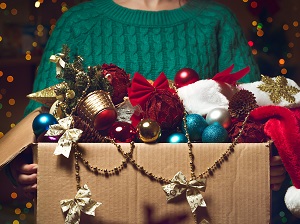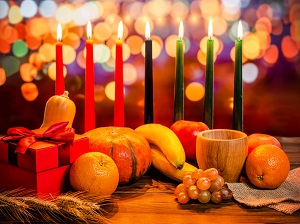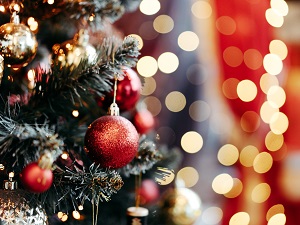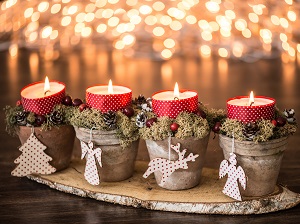The winter holiday season is a great time for festive decorations as friends, families, and co-workers come together for cherished annual traditions. Following some important safety tips while decorating for the holidays is a great first step towards ensuring a happy occasion for everyone.

Choose decorations that are flame resistant or flame retardant. Paper decorations can catch fire easily. Be sure to keep all decorations away from open flames and other heat sources like light bulbs and heaters.
Ensure all the smoke alarms in the home are working. As the weather cools and holiday activities begin, it’s a good idea to replace smoke alarm batteries. Keep exits clear of decorations, like the Christmas tree, so nothing blocks escape routes.
If younger children or pets are in the home, or will be attending a holiday event, avoid decorations that are sharp, breakable, have small pieces, or resemble food or candy that could be accidentally swallowed.
As you decorate for the holiday season, keep fire safety in mind.
Although Christmas tree fires are not common, when they do occur, they are more likely to be serious. A small fire that spreads to a Christmas tree can grow large very quickly. The most common causes of Christmas tree fires are caused by electrical problems or a heat source that is placed too close to the tree. Make sure the tree is at least three feet away from any heat source, like fireplaces, radiators, candles, heat vents, lamps, or light fixtures.
If you choose to decorate with a freshly cut tree, it is important that it doesn’t become too dry while inside the home. Choose a tree with fresh, green needles that do not fall off when touched. Before placing the tree in the stand, cut 2” from the base of the trunk. Add water to the tree stand. Be sure to add water daily.
Get rid of the tree after Christmas or when it is dry. Dried-out trees are a fire danger and should not be left in the home or garage or placed outside against the home. Check with your local community to find a recycling program.

If lit candles are used during the holidays, make sure to follow these safety tips: Use candle holders that won’t tip over easily. Candle holders should be placed on a sturdy, uncluttered surface. Candle placement is important. Do not place candles in any location that a person would need to reach or bend over to get to something else. Keep your hair and any loose clothing away from the flame. For an even safer option, consider using flameless candles in your home instead.
According to the NFPA, December is the peak month for home candle fires. Keep candles away from curtains, decorations, and anything else that might be flammable. Keep children and pets away from lit candles. Keep matches and lighters up high in a locked cabinet. Never use lit candles to decorate a Christmas tree. Blow out lit candles when you leave the room or go to bed.
If a Hanukkah menorah or a Kwanzaa kinara is part of your holiday tradition, choose a safe location for it on a sturdy, non-flammable surface (like glass, metal, or marble) that can’t be accidentally bumped by anyone. Never place a candle holder that will hold lit candles near or under any flammable materials like curtains, tapestries, or books.

Do not stand on furniture or any other object that is not meant for climbing on when hanging your holiday decorations. Whether inside or outside, use the correct ladder for the task. While hanging decorations, if a ladder must be set up in front of a door, make sure the door is locked, blocked open, or properly guarded.
To keep your balance, always maintain three points of contact—two hands and a foot or two feet and a hand—while climbing up or down a ladder. Always face the ladder when climbing. Don’t skip steps when climbing up or down. Be attentive to foot placement on each step and pay close attention to what you are doing. Exercise caution and look for every step.
Don’t overreach. Keep your center of gravity, and your body, between the side rails. If you can’t easily reach what you need, climb down and move the ladder for easier and safe access to the project area.
When using a step stool never place it on top of another object like a chair or a table. If additional height is required, use a ladder more suitable to the task that can be used safely.
Ensure extension ladders are placed at a proper angle before climbing up and when in use. For every four feet high, the base of the extension ladder should be one foot out away from the wall or other surface it is leaning against.

Some holiday lights and lighted decorations are only safe for indoor or outdoor use, not both, so make sure the lights you have are being used correctly.
Replace any string of lights with worn or broken cords or loose bulb connections. Read manufacturer’s instructions for the maximum number of light strands to connect safely. Do not overload electrical outlets with holiday lighting.
Inspect power cords (every year!) to ensure there is no damage to the cord or insulation. Check the rating on your extension cords to make sure they meet the power needs for the way they are being used. Use clips, not nails, to hang lights so the cords do not get damaged.
Outdoor extension cords, lights, and decorations should be plugged into outlets protected by ground fault circuit interrupters (GFCIs) or into portable outdoor GFCIs.
Turn off all Christmas tree lights, light strings, and any other lighted decorations before leaving home or going to bed. Bring outdoor electrical lights inside after the holidays to prevent hazards and to make them last longer.

.jpg)

